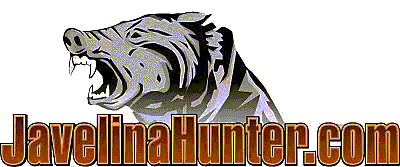
![]()
|

|
Herd Size Herd size has been recorded as ranging up to 15 animals in the tropical rain forest and an amazing 37 in the Sonoran desert scrub and grasslands of Arizona. Every hunting season there are reports of herds of 40 plus animals. In well over 20 years of hunting prime desert habitat, the largest herd I've encountered was 18 animals. Interestingly, a captive herd in a 600-arce fenced enclosure living in Arizona, protected from all hunting and predators, never exceeded 35 animals. The 11 year herd size average was 29 animals (1973-83). Unquestionably, hunting has a significant impact on populations. Several studies over a 10 year period of hunted herds indicate herd size averaged 8.6 animals (1972-81), with one hunt management unit recording the high of 12.3 animals per herd (sample size was 33 herds). Dynamics Javelina appear to maintain very close social relationships. They live in herds which are generally viewed as very cohesive; members eat, sleep, and forage together. Only rarely do aged or injured animals become solitary. If you were to view a herd undisturbed for 30 minutes, one of the first things you would notice is they are very gregarious, frequently rubbing against one another, vocalizing back and forth with barks, grunts, woofs and purrs.
They frequently "freshen-up" their herd mates, rocks, logs and brush with a pungent musk, released from a nipple-size gland near the base of the tail. In places where Javelina routinely bed, feed, or travel, the odor is very noticeable. Most experts believe their scent is probably an adaptation, used as a means of keeping informed about the activities and whereabouts of others in the herd. Herd hierarchy generally starts with the dominate boar and the remainder of the order is largely determined by size. Although they are highly social creatures, Javelina are not rigidly organized on the order of a pack of wolves. Juvenile or non-dominate boars are not driven out of the herd by the dominate boar. Neither adult boars or sows seem to serve as permanent leaders. There is some squabbling, but domination and status appear to be of relatively small concern. Studies in both Arizona and Texas indicate animals move into and join adjacent herds. Mostly males, primarily in the winter and spring, corresponding with peak breeding months. Forming a New Herd There are several opposing theories on how new herds are formed. It appears that availability of suitable "unclaimed" habitat, herd size, breeding/dominancy related occurrences are significant triggering factors. A study in Texas found herds divided into feeding sub groups (separate from the main herd) in the summer. An Arizona study revealed four adult males which fed and bedded together for almost six months, covering an area of 300 acres or about 25 percent of the territory size used by the main herd which surrounded them. When they were observed "with" the main herd significant chasing, tooth popping and mating behavior was observed--this suggests that the four were young subordinates or outsiders trying to join the herd, but were continually repulsed by the herd. Note: Acceptance of the four males by the herd was achieved with the coincidental disappearance of the two dominant males in the herd during the archery hunt. Territories are marked by rubbing of the rump gland against rocks, tree trunks, and stumps; this leaves smears of an oily fluid as a marker. Scat piles of defecation have also been observed along territorial borders and are believed to be markers. Both sexes actively defend the home range. Javelina fend off attackers by squaring off, laying back their ears, and clattering their canines. In fight, they charge head-on, bite, and occasionally lock jaws. Feeding Feeding Javelina (click on photo to enlarge) Photo by AP Jones.Feeding activity depends on temperature and food availability. Javelina are more nocturnal in the hotter summer months. In Texas, studies revealed peccaries to be nocturnal in the spring, summer, and fall and very active during the daylight hours in the winter months. Feeding subgroups are formed frequently, and sometimes even serve as the initial nucleus of a break-off from the original herd. Scent Javelina maintain contact through scent marking and a variety of vocalizations. Javelina scent can be best described as a "musty smell" similar to a skunk, but not as strong. When approaching from down wind it's very common to smell them before you see them. The scent gland (on its back) is rubbed against tree trunks, rock outcroppings, and other objects for territorial marking. The dorsal rump gland is also used as recognition and identification. In greeting, herd members rub each other, head to rump. Common Vocalizations Javelina are moderately vocal, they make several distinctive vocalizations/noises. These vocalizations can be classified into three general categories: aggressive, content, and alert. Aggressive "Growls" Generally fairly loud, can be heard at ranges approaching 150 yards. Normally associated with aggressive behavior between two Javelina "Tooth clicking" Rapid fire snapping of the upper and lower jaw. It's best described as similar to hitting two bones together at a machine gun rate. Very intimidating!. Used as a warning, as an attack may follow. Cornered, wounded, or distressed animals often make this sound. Content "Grunts" Individual animals will often times make constant (low-volume) grunts while feeding or engaged in herd activity. Alert "Woofs" Generally made when startled, spooked, or disturbed. Herd will either cease all activity and freeze in an attempt to determine source of danger or will run while continually making "woof" call. "Squealing" Piglets will often squeal when separated from sow or harassed. Herd members generally respond to piglet "squeals". Note to readers. The Javelina University section was developed from information derived from over 20 different Javelina related informational sources. Please visit the References page.
|

|
|
JavelinaHunter.com and JavelinaHunter are registered trademarks.
|